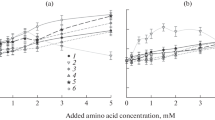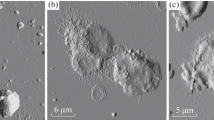Abstract
A heat-stable factor present in extracts of human blood leukocytes is capable of lysing youngStaphylococcus aureus at pH 5.O. Lysis is characterized by breakdown of cell-wall components as judged by electron microscopic and biochemical analysis. The leukocyte extracts can be replaced by a variety of agents known to injure cell membranes, e.g., leukocyte cationic protein histone, polymyxin B, colimycin, phospholipase A, and lysolecithin. The mechanisms by which all these agents bring about the degradation of the staphylococcal walls was studied. By using14C-labeled cell walls devoid of cytoplasmic structures, it was demonstrated that none of the above-mentioned agents had a direct lytic effect on purified cell walls. On the other hand, when any of these agents first interacted with intact staphylococci, a factor (presumably an autolysin) was generated that directly lysed the cell walls. Lysis of cell walls in the presence of intact staphylococci used as a source of autolysin was strongly inhibited by a variety of anionic polyelectrolytes such as heparine and liquoid. The possible role played by bacterial autolysins in the generation of microbial cell-wall components capable of triggering chronic inflammation is discussed.
Similar content being viewed by others
References
Archibald, A.R. 1972. The chemistry of staphylococcal cell walls.In The staphylococci. J.O. Cohen, editor. Interscience, New York. 75–109.
Beckerdite, S., C. Mooney, J. Weiss, R. Franson, andP. Elsbach. 1977. Early and discrete changes in permeability ofEscherichia coli and certain other Gram-negative bacteria during killing by granulocytes.J. Exp. Med. 140:396–409.
Efrati, C., T. Sacks, N. Ne'eman, M. Lahav, andI. Ginsburg. 1976. The effect of leukocyte hydrolases on bacteria. VIII. The combined effect of leukocyte extracts, lysozyme, enzyme “cocktails,” and penicillin on the lysis ofStaphylococcus aureus and group A streptococci in vitro.Inflammation 1:371–407.
Ehrlich, J., M.Lahav, and M.N.Sela. 1976. The bacteriolytic effect of human dentoalveolar purulent exudates and leukocyte extracts. Submitted for publication.
Franson, S.A., P. Patriarca, andP. Elsbach. 1974. Phospholipid metabolism by phagocytic cells. Phospholipases A2 associated with rabbit polymorphonuclear leukocyte granules.J. Lipid Res. 15:380–388.
Ginsburg, I., N. Ne'eman, Z. Duchan, M.N. Sela, J.M. James, andM. Lahav. 1975. The effect of leukocyte hydrolases on bacteria. IV. The role played by artificial enzyme “cocktails” and tissue enzymes in bacteriolysis.Inflammation 1:45–56.
Ginsburg, I., M.Lahav, N.Ne'eman, Z.Duchan, S.Chanes, and M.N.Sela. The interaction of leukocytes and their hydrolases with bacteria in vitro and in vivo: The modification of the bactericidal and bacteriolytic reactions by cationic and anionic macromolecular substances and by anti-inflammatory agents.Agents Actions 6:292–305.
Ginsburg, I., M. Lahav, N. Ne'eman, andJ.M. James. 1974. The inhibition by basic and acidic polyelectrolytes of the degradation of bacteria by leukocyte enzymes: Relation to the persistence of microbial constituents in inflammatory sites.In Activation of Macrophages. W.H. Wagner, H. Hahn, and R. Evans, editors. Excerpta Medica, Amsterdam. 162–169.
Ginsburg, I., andM.N. Sela. 1976. The role of leukocytes and their hydrolases in the persistence, degradation and transport of bacterial constituents in tissues: Relation to chronic inflammatory processes in staphylococcal, streptococcal and mycobacterial infections and in chronic periodontal disease.Crit. Rev. Microbiol. 4:249–331.
Koga, T., S. Rotani, T. Narita, andC.M. Pearson. 1976. Induction of adjuvant arthritis in the rat by various bacterial cell walls and their water-soluble components.Int. Arch. Allergy Appl. Immunol. 51:206.
Lahav, M., N. Ne'eman, E. Adler, andI. Ginsburg. 1974. Effect of leukocyte hydrolases on bacteria. I. Degradation of14C-labeIed streptococcus and staphylococcus.J. Infect. Dis. 129:528–537.
Lahav, M., N. Ne'eman, J. James, andI. Ginsburg. 1975. The effect of leukocyte hydrolases on bacteria. III. Bacteriolysis induced by extracts of different leukocyte populations and the inhibition of lysis by macromolecular substances.J. Infect. Dis. 131:149–157.
Ne'eman, N., M. Lahav, andI. Ginsburg. 1974. The effect of leukocyte hydrolases on bacteria. II. The synergistic action of lysozyme and extracts of PMN, macrophages, lymphocytes and platelets in bacteriolysis.Proc. Soc. Exp. Biol. Med. 146:1137–1145.
Ne'eman, N., Z. Duchan, M. Lahav, M.N. Sela, andI. Ginsburg. 1976. The effect of leukocyte hydrolases on bacteria. VII. Bactericidal and bacteriolytic reactions mediated by leukocyte and tissue extracts and their modifications by polyelectrolytes.Inflammation 1:261–284.
Ne'eman, N., andI. Ginsburg. 1972. Red cell sensitizing antigen of group A streptococci. II. Immunological and immunopathological properties.Isr. J. Med. Sci. 8:1807–1816.
Page, R.C., P. Davies, andA.C. Allison. 1974. Participation of mononuclear phagocytes in chronic inflammatory diseases.J. Reticuloendothel. Soc. 15:413–438.
Salton, M.R.J., andJ.G. Pavlik. 1960. Studies of the bacterial cell wall. VI. Wall composition and sensitivity to lysozyme.Biochim. Biophys. Acta 39:398–407.
Schwab, J.H., W.J. Cromartie, S.H. Ohanian, andJ.E. Craddock. 1967. Association of experimental chronic arthritis with the persistence of group A streptococcal cell walls in the articular tissue.J. Bacteriol. 94:1728–1735.
Sela, M.N., M. Lahav, N. Ne'eman, Z. Duchan, andI. Ginsburg. 1975. The effect of leukocyte hydrolases on bacteria. V. Modification of bacteriolysis by antiinflammatory agents and by cationic and anionic polyelectrolytes.Inflammation 1:57–69.
Sela, M.N., M. Lahav, andI. Ginsburg. 1977. The effect of leukocyte hydrolases on bacteria. IX. The release of lipoteichoic acid from group A streptococci and fromStrep, mutans by leukocyte extracts and by lysozyme.Inflammation 2:151–164.
Stein, H., R. Yarom, S. Levine, T. Dishon, andI. Ginsburg. 1973. Chronic self-perpetuating arthritis induced in rabbits by a cell free extract of group A streptococci.Proc. Soc. Exp. Biol. Med. 143:1106–1112.
Strominger, J.L., andGhusen, J.M. 1967. Mechanisms of enzymatic bacteriolysis.Science 156:213–217.
Suganuma, A., 1972. Fine structure of staphylococci: Electron microscopy.In The Staphylococci. J.O. Cohen, editor. Interscience, New York. 213–217.
Takeba, I., H.J. Singer, E.M. Wise, andJ.T. Park. 1970.Staphylococcus aureus H. autolytic activity: General properties.J. Bacteriol. 102:14–19.
Tipper, D.J. 1969. Mechanism of autolysis of isolated cell walls ofStaphylococcus aureus.J. Bacteriol. 97:837.
Wadström, T., andK. Hisatsune. 1970. Bacteriolytic enzymes fromStaphylococcus aureus. Specificity of action of endo-β-N-acetylglucosaminidase.Biochem. J. 120:735–744.
Wadström, T. 1973. Bacteriolytic enzymes from staphylococci. Contributions to Microbiology and Immunology. Vol. 1. Staphylococci and Staphylococcai Infections. Karger, Basel. 397–405.
Weiss, J., R.C. Franson, S. Beckerdite, K. Schmeidler, andP. Elsbach. 1975. Partial characterization and purification of a rabbit granulocyte factor that increases permeability ofEscherichia coll.J. Clin. Invest. 55:33–42.
Weiss, J., R.C. Franson, J. Schmeidler, andP. Elsbach. 1976. Reversible envelope effects during and after killing ofEscherichia coli W by a highly purified rabbit polymorphonuclear leukocyte fraction.Biochim. Biophys. Acta 436:154–169.
Author information
Authors and Affiliations
Additional information
This study was supported by grants from the Joint Research Fund of the Hebrew University-Hadassah School of Dental Medicine, founded by the Alpha Omega Fraternity, and the Hadassah Medical Organization; by grants from the Chief Scientist, the Ministry of Health, Government of Israel; and the Max Bogen Research Fund, obtained through the Friends of the Hebrew University in the United States.
Rights and permissions
About this article
Cite this article
Lahav, M., Ginsburg, I. Effect of leukocyte hydrolases on bacteria. Inflammation 2, 165–177 (1977). https://doi.org/10.1007/BF00918678
Issue Date:
DOI: https://doi.org/10.1007/BF00918678




